|
Fly of
the Month
Bob Ireton brings together his
experience in fly fishing, aquatic entomology, and knowledge of fly
tying techniques and materials, to design and tie durable and
effective flies.
|

|

Volume 6, Issue
12 December
2005

DRESS WULFF
Fly, Text, and Photography by Bob Ireton
There are not many people that fly fish, or tie flies, that haven’t
heard of the legendary Lee Wulff. Not only did he develop and tie some
great fly designs, he tied without the aid of a tying vise, using only
his hands. Around 1931, he developed his ‘WULFF’ series of flies. Most
of us are familiar with the ‘Royal Wulff’. Can you even imagine tying
this fly only using your fingers, and no tying vise?
The ‘Royal Wulff’ is a beautiful fly that fishes well, and also looks
great on the hatband of your favorite hat. I have taken the liberty of
tying a modified version of this fly to wear on your hatband. Feel free
to modify this design however you like. It will look great on your
favorite hat!
By looking at the archives of the ‘Fly of the Month’, you will see
that I have done this article each month for the past five years. I hope
you, the readers, have enjoyed my efforts, and have learned some tying
techniques in the process. The ‘Dress Wulff’ is my final fly, and Joe
Cornwall will be doing the FOTM starting in January, 2006.
Best Regards,
Bob Ireton
December, 2005
MATERIALS
Hook – TMC7989, or equivalent.
Size – 2-6.
Thread – Orange, 3/0 & 6/0.
Wing – White calf body hair.
Tail – Moose body hair.
Body – Peacock herl, red, white, and blue floss.
Hackle – Brown.
TYING STEPS
| 1 – For this fly, I am using a TMC 7989, in size
6. The hook is forged to be strong, and has a black finish that looks
good. I think any size smaller than 6 would be too small to look right
on a hatband. Bigger is good, but you will find that tying a large fly
is as difficult as tying a small size, due to the difficulty in finding
appropriate sized materials. Place the hook properly in the vise. Don’t
mash the barb down, as it will help hold the fly in the hatband. |
 |
| 2 – Using 3/0 thread, apply a double layer of thread for
the base. If you use a whip finish to secure the thread, it will be
smooth, and not noticeable like half hitches. Snip off the 3/0 thread. |
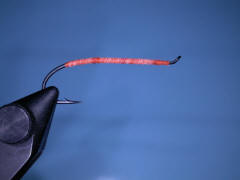 |
| 3 – For most people, the wings are the most difficult
part of this fly. I do the wings now, so if they get screwed up past
repair, I will not have wasted my time on other parts of the fly. Attach
the 6/0 working thread behind the hook eye. I snip off some calf body
hair of the needed length, and comb out the underfur at the base. Then
place in a stacker ‘tip first’. Tap the base of the stacker on a solid
surface to line up the tips of the hair. As this is a large size, I
actually do the above step twice, once for each wing. The wing should be
upright approximately 1/4 hook shank length behind the eye, and the
height should be approximately the length of the hook shank. I tie the
wings in one at a time. Now secure both wings together, facing forward,
and then snip off the excess hair with a rearward sloping cut. Now
finish securely tying in the butts of the hair. |
 |
| 4 – Lift the wings upright, and tie wraps of thread in
front of the wings to hold them in this position. Then separate the
upright hair into two wings of equal diameter, and use figure eights to
keep them in this position. I then wrap the thread up the base of each
each wing with spaced wraps, and then come back down using tight, close
wraps. When the wings look right to you, bring the thread back to the
tail tie-in position, and tie a half hitch. I put some head cement on
the thread all around the wings and base to insure the hair remains in
place. |
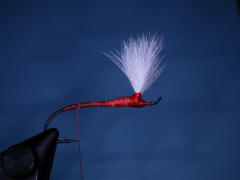 |
| 5 – Snip several hairs from the hide of the moose, and
comb out the underfur. Stack to align the tips. Lay the hair on top of
the hook with the tips facing rearward, and adjust so the tail is the
length of the hook shank. Tie the tail in, snip off the butts, and
finish securing the hair. Tie a half hitch. |
 |
|
6 – Select two nice, long peacock herls, snip off the weak ends, and
tie in by the tips at the base of the tail. |
 |
| 7 – Palmer the herl, one strand at a time, to form a
band. Tie off, then half hitch. Do not cut off the herl! Now tie in a
piece of the blue floss. Tie a half hitch. |
 |
| 8 – Palmer the blue floss over the tag ends of the herl
to form a band of the floss several wraps thick. Secure with the working
thread, and tie a half hitch. Snip off the tag end of the blue floss,
and tie in a piece of the white floss. Tie a half hitch. |
 |
| 9 – Make a band with the white floss right over the herl,
as before. Secure, snip off the white tag, and tie a half hitch. Now tie
in a piece of red floss. Tie a half hitch. |
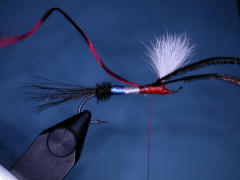 |
| 10 – Palmer the red floss over the herl as before to
make the red band. Secure as in previous step.
|
 |
| 11 – Form a band with the peacock herl. Secure, and snip
off the tag ends of the herl. Tie a half hitch. |
 |
| 12 – Since this fly won’t be used for fishing, and due
to its large size, don’t worry about finding dry fly hackle big enough.
I found a proper sized feather on a saddle. Cut off the weak tip, and
cut off the fibers on the side of the feather shaft that will lie
against the hook shank. Shiny side will face the hook eye. Tie in the
hackle feather by the tip, next to the herl band. Tie a half hitch. |
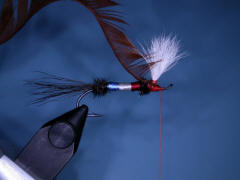 |
| 13 – Palmer the hackle on each side of the wing. I
needed more hackle than the first feather provided, so I tied in a
second feather to finish. Tie off the hackle, and snip off the excess,
and form a head. Tie a couple of half hitches, and then a whip finish.
Snip off the working thread. Apply cement to the head. Use your fingers
and bodkin to dress up the fly. |
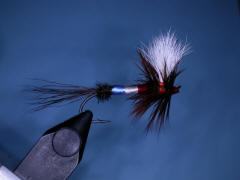 |
| 14 – Cut a small piece of foam, and run the point of the
hook into the foam. Since you left the barb intact, it will lock into
the foam. Now slide the foam with the attached fly into the band of your
favorite hat. Enjoy! |
 |
The Buckeye United Fly
Fishers, Inc is a non-profit corporation organized under section 501(c)(3)
of the Internal Revenue Code, incorporated in the State of Ohio for the
preservation, conservation and wise use of our fishing waters and game
fish; and to assist in the protection and improvement of our natural
resources
|

![]()
![]()













